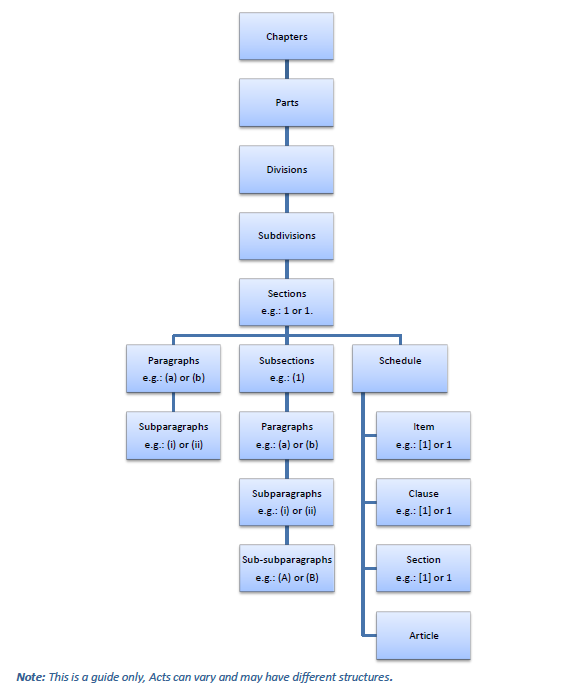Structure of a law
How are laws normally identified?
The Acts and instruments found on the Register and in print can usually be referenced in one of two ways:
- by its (short) title - this is normally set out in the first provision of the law, normally includes a financial or calendar year, and may include a number if a law with a similar title has been published in that period. For example: Appropriation Act (No. 3) 2009-2010.
- by its series year and number - as Acts are made each year, each one is numbered with 1 being the first Act of the year. The above Appropriation Act is Act No. 24, 2010. Other types of laws may use other periods and numbering systems as a reference.
All law published on the Register will also have a unique Register ID number that can be used to find it using the search field at the top of every page of the website. The ID number of a document is found on the relevant webpages and in URLs, and on every page of authorised pdf versions of documents.
How are laws normally laid out?
While their content varies enormously, most Acts and instruments on the Register are laid out in the same way.
The first few pages of a law generally provide information about the law and an overview of the document such as the title page and table of contents. The middle section contains the provisions that make up the body of a law and are numbered sequentially, with chapter, part, division, subdivision and schedule headings to assist the reader. The final pages usually contain the endnotes, information on the history of the particular law, details of amendments that been incorporated, and other process information. To fully understand a particular provision in a law it is usually necessary to read several other related provisions, general provisions such as commencement, application and definitions and in many cases the whole law and possibly related laws.
How is text in the body of a law usually identified?
The text in the body of a law is organised into provision units that make it easier to read the document. The most commonly used are as follows:
| Acts | Regulations and other instruments | Rules of Court |
|---|---|---|
| section | section | rule |
| subsection | subsection | subrule |
| paragraph | paragraph | paragraph |
| subparagraph | subparagraph | subparagraph |
| sub-subparagraph | sub-subparagraph | sub-subparagraph |
As the provisions are numbered sequentially, if new material is inserted later, a letter or letters may be added to a number, to keep the numbering system flexible. For example, 5A may be inserted between 5 and 6.
Example structure of an Act
Below you will see a common hierarchy of Act components, starting with chapters and working downwards through other organisational components (parts, divisions and subdivisions) until we reach the provision units most commonly found in Acts (sections, subsections, paragraphs, subparagraphs, items, clauses and articles). The structure presented below is a guide only; not all Acts are structured using all of the components identified. A small Act, for example, may not need to be organised into chapters and instead will be structured in parts to make navigating its content easier.

